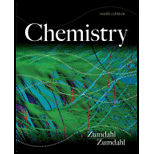
Concept explainers
(a)
Interpretation: It is given that, nitrogen reacts with hydrogen gas (in a container) to produce ammonia gas. The volume of this mixture and total pressure is given. The partial pressure and mole fraction of ammonia in a container during completion of reaction is to be calculated. The volume of container during the completion of reaction is to be calculated.
Concept introduction: The volume is calculated using
The mole fraction of ammonia is calculated using the formula,
To determine: The partial pressure of ammonia in a container during completion of reaction.
(b)
Interpretation: It is given that, nitrogen reacts with hydrogen gas (in a container) to produce ammonia gas. The volume of this mixture and total pressure is given. The partial pressure and mole fraction of ammonia in a container during completion of reaction is to be calculated. The volume of container during the completion of reaction is to be calculated.
Concept introduction: The volume is calculated using ideal
The mole fraction of ammonia is calculated using the formula,
To determine: The mole fraction of ammonia in a container during completion of reaction.
(c)
Interpretation: It is given that, nitrogen reacts with hydrogen gas (in a container) to produce ammonia gas. The volume of this mixture and total pressure is given. The partial pressure and mole fraction of ammonia in a container during completion of reaction is to be calculated. The volume of container during the completion of reaction is to be calculated.
Concept introduction: The volume is calculated using ideal gas law,
The mole fraction of ammonia is calculated using the formula,
To determine: The volume of container during the completion of reaction.
Trending nowThis is a popular solution!
Learn your wayIncludes step-by-step video

Chapter 20 Solutions
Chemistry
- What possible uses exist for the natural gas liquids that are removed from natural gas during its processing?arrow_forwardFollow the directions of Question 29 for the following compounds: (a) solid ammonium nitrate (b) liquid methyl alcohol (c) solid copper(II) sulfidearrow_forwardChlorine trifluoride, ClF3, is a valuable reagent because it can be used to convert metal oxides to metal fluorides: 6 NiO(s) + 4 ClF3(g) 6 NiF2(s) + 2 Cl2(g) + 3 O2(g) (a) What mass of NiO will react with ClF3 gas if the gas has a pressure of 250 mm Hg at 20 C in a 2.5-L flask? (b) If the ClF3 described in part (a) is completely consumed, what are the partial pressures of Cl2 and of O2 in the 2.5-L flask at 20 C (in mm Hg)? What is the total pressure in the flask?arrow_forward
- If an electric current is passed through molten sodium chloride, elemental chlorine gas is generated as the sodium chloride is decomposed. :math>2NaCl(1)2Na(s)+Cl2(g) at volume of chlorine gas measured at 767 mm Hg at 25 °C would be generated by complete decomposition of 1.25 g of NaCl?arrow_forwardUse the appropriate tables to calculate H for (a) the reaction between copper(II) oxide and carbon monoxide to give copper metal and carbon dioxide. (b) the decomposition of one mole of methyl alcohol (CH3OH) to methane and oxygen gases.arrow_forwardHow does hydraulic fracturing differ from previously used techniques for the recovery of natural gas from the earth?arrow_forward
- 76. Dry air is 78% nitrogen gas, 21% oxygen gas, and 0.9% argon gas. These gases can be separated by distillation after the air is first converted to a liquid. In one of the steps in this process, filtered air is compressed enough to increase the pressure to about 5.2 atm. To what volume must 175 L of air at 1.0 atm be compressed to yield a pressure of 5.2 atm? The argon derived from the distillation of air can be used in fluorescent light bulbs. When 225 L of argon gas at 0.997 atm are distilled from the air and allowed to expand to a volume of 91.5 m3, what is the new pressure of the gas in pascals?arrow_forwardConsider the Haber process shown below. N2 (g) + 3 H2 (g) → 2 NH3 (g) Which of the following statements IS NOT TRUE? Assume 100% yield. 28 grams of nitrogen gas reacts with 6 grams of hydrogen gas to form 34 grams of ammonia gas. 5 molecules of nitrogen gas reacts with 15 molecules of hydrogen gas to form 10 molecules of ammonia gas. 15 moles of nitrogen gas reacts with 45 moles of hydrogen gas to form 30 moles of ammonia gas. 25 grams of nitrogen gas reacts with 75 grams of hydrogen gas to form 50 grams of ammonia gas.arrow_forwardAncient Romans built often out of bricks and mortar. A key ingredient in their mortar was quicklime (calcium oxide), which they produced by roasting limestone (calcium carbonate). 1. Write a balanced chemical equation, including physical state symbols, for the O-0 decomposition of solid calcium carbonate (CaCO3) into solid calcium oxide and gaseous carbon dioxide. x10 Ar 2. Suppose 86.0L of carbon dioxide gas are produced by this reaction, at a temperature of 230.0 °C and pressure of exactly 1 atm. Calculate the mass of calcium carbonate that must have reacted. Be sure your answer has the correct number of significant digits.arrow_forward
 Chemistry: An Atoms First ApproachChemistryISBN:9781305079243Author:Steven S. Zumdahl, Susan A. ZumdahlPublisher:Cengage Learning
Chemistry: An Atoms First ApproachChemistryISBN:9781305079243Author:Steven S. Zumdahl, Susan A. ZumdahlPublisher:Cengage Learning
 ChemistryChemistryISBN:9781305957404Author:Steven S. Zumdahl, Susan A. Zumdahl, Donald J. DeCostePublisher:Cengage Learning
ChemistryChemistryISBN:9781305957404Author:Steven S. Zumdahl, Susan A. Zumdahl, Donald J. DeCostePublisher:Cengage Learning Introductory Chemistry: A FoundationChemistryISBN:9781337399425Author:Steven S. Zumdahl, Donald J. DeCostePublisher:Cengage Learning
Introductory Chemistry: A FoundationChemistryISBN:9781337399425Author:Steven S. Zumdahl, Donald J. DeCostePublisher:Cengage Learning Principles of Modern ChemistryChemistryISBN:9781305079113Author:David W. Oxtoby, H. Pat Gillis, Laurie J. ButlerPublisher:Cengage Learning
Principles of Modern ChemistryChemistryISBN:9781305079113Author:David W. Oxtoby, H. Pat Gillis, Laurie J. ButlerPublisher:Cengage Learning Chemistry: The Molecular ScienceChemistryISBN:9781285199047Author:John W. Moore, Conrad L. StanitskiPublisher:Cengage Learning
Chemistry: The Molecular ScienceChemistryISBN:9781285199047Author:John W. Moore, Conrad L. StanitskiPublisher:Cengage Learning





